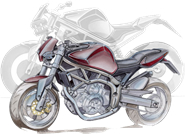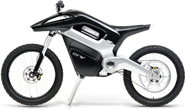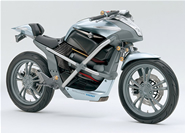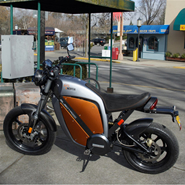Issues of green motorcycle design
 This article looks at the issues of more environmentally sustainable motor cycle design. It can be used to promote classroom discussion on the values laden and values dependent nature of design – discussion topics for this can be found on the accompanying curriculumfocus page on Values education.
This article looks at the issues of more environmentally sustainable motor cycle design. It can be used to promote classroom discussion on the values laden and values dependent nature of design – discussion topics for this can be found on the accompanying curriculumfocus page on Values education.
For more than 100 years, the internal combustion engine has ruled the highways and by-ways of the world. Now, as concerns about climate change and the rising cost of oil take centre stage, the search is on for alternative, cleaner, and cheaper options. Fuel cells, bio-fuel, electric engines or hybrid systems, along with improvements to conventional engines, look set to change transportation. Exactly which technologies will emerge as winners is yet to be seen, but one thing is certain: the auto industry is about to undergo an extreme makeover.
In his capacity as senior Industrial and Transport Design lecturer at Massey University’s Auckland School of Design Oliver Neuland encourages his students to create environmentally-friendly, sustainable energy-fuelled vehicles and transport systems. The challenge in doing so, he says, is to incorporate energy efficient methods whilst creating an aesthetically pleasing vehicle.
“Designers have to bear in mind that car buyers still want their vehicles to conform to certain aesthetic standards, no matter how clean and green their inner workings.”
The challenge is even more difficult with motorcycles, Mr Neuland says: “The separation between body and inner technology is not so clear. For motorcyclists – who are even more emotionally attached to their machines – the mechanics are a core part of the beauty of their vehicle.”
 Mr Neuland knows. Besides two years (1996-97) spent at BMW’s department of motorcycle design in Munich, he was a member of the design team which developed the the Mastiff and Baghira models for German motorcycle producer MZ motorcycles, and made clay models for BSA Bantam bike designs. In 2004 he organised one of the biggest ever international motorcycle design competitions in Munich, attracting 150 entries and backing from BMW, Yamaha, Honda and Kawasaki. He is a passionate motorcyclist and, when time allows, gets out on the open road on his Triumph 900cc motorbike.
Mr Neuland knows. Besides two years (1996-97) spent at BMW’s department of motorcycle design in Munich, he was a member of the design team which developed the the Mastiff and Baghira models for German motorcycle producer MZ motorcycles, and made clay models for BSA Bantam bike designs. In 2004 he organised one of the biggest ever international motorcycle design competitions in Munich, attracting 150 entries and backing from BMW, Yamaha, Honda and Kawasaki. He is a passionate motorcyclist and, when time allows, gets out on the open road on his Triumph 900cc motorbike.
Motorcycles have been around almost as long as automobiles and it seems their time has come. They are enjoying a surge in popularity as more and more people recognise the advantages of using motorcycles for everyday commuting and transportation. Beside their light environmental footprint, their convenience, particularly in congested cities, the popularity of motorcycles is being driven by growing disenchantment with the environmental impact of automobiles and the rising costs of fuel.
The same clean technologies being developed for cars, will be applied to motorcycles. However, changing motorcycles to eco-friendly technology is a much bigger design challenge than applying the technology to automobiles, Mr Neuland says. The ‘heart’ of a “clean” engine beats differently and using one changes the proportions of a motorcycle dramatically.
 In applying clean technologies, motorcycle designers have to grapple with many non-technical issues. Apart from their practical values, motorcycles embrace a number of intangible cultural and personal values: since the 1950s motorcycles have become powerful symbols of freedom of the open road and the spirit of rebelliousness. Mr Neuland says designers will not only need a sound knowledge and appreciation of the technical engineering realities, but have to find a way to accommodate the cultural values embodied in motorcycles.
In applying clean technologies, motorcycle designers have to grapple with many non-technical issues. Apart from their practical values, motorcycles embrace a number of intangible cultural and personal values: since the 1950s motorcycles have become powerful symbols of freedom of the open road and the spirit of rebelliousness. Mr Neuland says designers will not only need a sound knowledge and appreciation of the technical engineering realities, but have to find a way to accommodate the cultural values embodied in motorcycles.
Designers will also have to design for emotional values. Does a market exist for silent, odourless, vibration-free machines? Or does creating such a machine miss the essential point of riding a motorcycle in the first place? Designers design for the real world: to operate successfully they must develop a sense whether there is a market for their innovative designs. Given the fuel efficiency of motorcycles today, why, they may ask themselves, embrace new the new technologies at all?
Motorcycle designers don’t operate in a vacuum. They are subject to the same influences and forces as the rest of the design community. Design, be it product design, architecture or software writing, is undergoing a revolution, fuelled by popular demand for sustainability. An important part of any designer’s job is to design for changing customer expectations.
 How to proceed? By grafting new technologies onto existing designs? Or by creating something entirely new from first principles? Is there any point in designing new motorcycles by simply adding green technology to existing designs or should designers seize the opportunity to radically change motorcycle design by coming up with completely new solutions? These new solutions may satisfy a previously unrecognised demand in the market or even create a demand that previously didn’t exist. However they proceed, designers will also have to design for persuasion: they will have to must create products potential buyers clients find desirable.
How to proceed? By grafting new technologies onto existing designs? Or by creating something entirely new from first principles? Is there any point in designing new motorcycles by simply adding green technology to existing designs or should designers seize the opportunity to radically change motorcycle design by coming up with completely new solutions? These new solutions may satisfy a previously unrecognised demand in the market or even create a demand that previously didn’t exist. However they proceed, designers will also have to design for persuasion: they will have to must create products potential buyers clients find desirable.
Technological solutions to complex problems are rarely simple ones. Typically, new technologies must work with pre-existing technologies and fit into systems already in place or new technologies may combine with other technologies to form a new system. Population growth and suburban-style planning have led to traffic congestion and increased collisions. There is little use in developing clean motorcycles only to have their owners forced to operate them in unsafe conditions. To reduce dependence on the automobile, urban planners and traffic authorities have adopted a range of strategies, including encouraging the development of public transit and pedestrian-friendly communities. Designers may have to become involved in changing existing infrastructure to create safer operating environments for their products. And designers may have to become involved in political/legislative/educational initiatives to change attitudes of road users as well.
